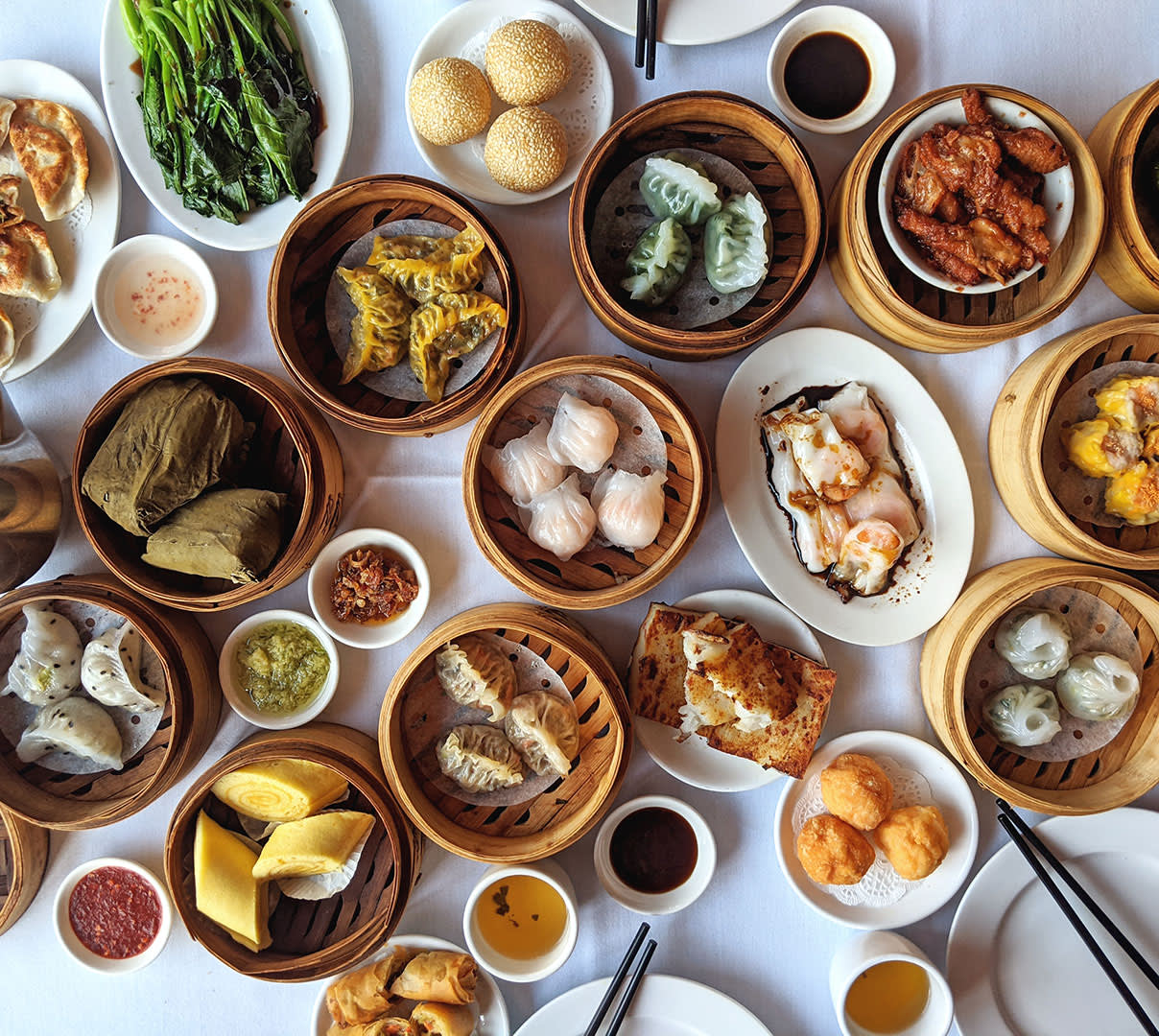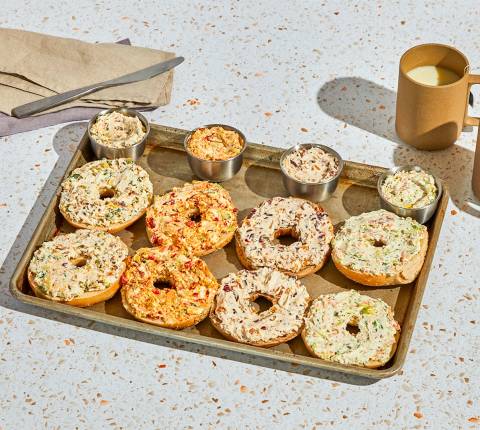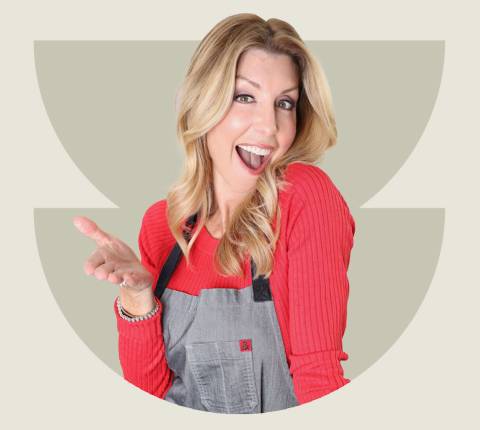Few meals are more fun than dim sum, the ultimate eat-with-your-eyes experience. No menus are required in the traditional palaces; all you have to do is look, point, and eat as carts full of perfect bites bustle through the dining room. While the Chinese small-plates dining ritual became popularized as a daytime feast, dim sum is not just for brunch anymore. A dim sum spread is delicious anytime of day or night, a celebratory indulgence that turns a meal into a special occasion.
Whether you're flagging down dim sum carts in person or perusing a menu at home, you may be overwhelmed by the seemingly endless offerings. So many options present a dilemma: Which to choose? That’s where our experts come in. We asked Vera Chan-Waller, proprietor of the San Francisco classic Yank Sing, and Eric Lee, operations manager of NYC hot spot Dim Sum Go Go in Chinatown, for their insights on the ultimate dim sum order. Stick by their seasoned strategies for the best way to enjoy dim sum at home.

Photo credit: Allie Tong, Yank Sing
First, follow your heart…
Dim sum literally translates to “touch the heart,” which, Chan-Waller says, “is why you should order anything that touches your heart. Anything comforting that calls to you is the right thing to choose.” The dish that touches her heart the most? The chicken-mushroom dumplings that have been on Yank Sing’s menu since 1958 — and are just one of more than 100 dishes in rotation. “In Chinese, there’s a word for a unique flavor that we call wok hei,” she says. “This is the aromatic quality that a wok gives to a dish. Those chicken-mushroom dumplings are a prime example of that.”
…but definitely get the dumplings.
Dumplings are considered staples of dim sum, and, according to both Chan-Waller and Lee, among those you should not miss are shumai, steamed dumplings usually filled with shrimp, pork, or both; snow pea leaf dumplings, a vegetarian favorite which can also include shrimp; and xiao long bao, dumplings filled with hot soup, a skillfully made staple at Din Tai Fung in Seattle. Har gow, tender shrimp in a translucent wrapper, also often called crystal shrimp dumplings, are the standard by which Lee judges a dim sum meal. “I always order them, and if the skin is very delicate, I know I am in for a good dim sum experience,” he says.

Photo credit: Din Tai Fung
Move on to the other musts.
Chan-Waller and Lee suggest starting with dumplings and smaller bites before moving on to heartier dishes. They highlight fried spring rolls; cheong fun, steamed rice noodle rolls stuffed with meat, seafood, or vegetables; and char siu bao, steamed barbecue pork in fluffy buns, as other worthy bites. Chan-Waller especially enjoys ordering in spare ribs and long life noodles, as “they hold up to delivery really well.” And don’t overlook the vegetables, like sautéed string beans, a particular favorite at Dumpling House in Cambridge, Massachusetts, and a great complement to most everything on a dim sum menu.

Photo credit: Christine Wong, Dim Sum Go Go
Be adventurous.
While diners new to dim sum might not order chicken feet at first, Lee says that “when done well, they are really worth it and can enhance the entire dim sum experience. Restaurants that serve them usually put a lot of effort into them.” This deep-fried, steamed, and stewed delicacy is a point of pride for many dim sum spots, such as LA’s ABC Seafood, where they are simmered in black bean sauce. Turnip cakes or the even rarer radish cakes are other dishes that dim sum aficionados never pass up because of their unique texture. Lee also endorses “trying the sticky rice bundle instead of the usual white rice,” such as the one served at New Furama in Chicago: sticky rice with pork, sausage, mushroom, and salted egg, all wrapped in a lotus leaf.
Skip the microwave.
If you want to reheat any items, Chan-Waller says the oven is the way to go. “If I’m reheating spring rolls, for example, I would just stick them in the oven on low heat, and cover them with a little gap — put the cover on sideways — so they stay warm and don’t get soggy,” she advises. “I would never microwave dim sum because it tends to take the moisture out of everything.”
Drink dim sum with…
“Tea!” Lee says emphatically. After all, dim sum’s roots lie in 19th-century tea rooms. “It is the most traditional accompaniment,” he says, and no proper dim sum feast is complete without at least one pot. Fine teas continue to be a specialty at legendary dim sum parlors, such as New York’s Nom Wah, which opened in 1920 and where a selection of varieties are available for in-person dining at the restaurant’s locations in Chinatown and Philadelphia. Beyond tea, Chan-Waller recommends pairing beer and white wine with dim sum. “I sometimes like to have a cold Tsingtao or a light sauvignon blanc with dim sum,” she says. “A riesling will bring out the sweeter elements in some dishes too.”

Photo credit: Simon Leong, Nom Wah Tea Parlor
Plan a sweet finish.
Chan-Waller heartily recommends capping off a dim sum meal with jian dui (sesame balls), deep-fried sweet rice flour balls dotted with sesame seeds. Not only are they one of China’s most ubiquitous sweets, but they are a top order at popular restaurants, such as HK Cafe in Portland, Oregon. Lee adds, “Everybody loves a nice mango pudding, or a classic egg custard tart,” both of which are perfect for delivery.
Don’t forget to share.
Chan-Waller’s final hard-and-fast rule: “You can order anything you want, but when you receive it, there’s no hogging. You have to share and eat everything family-style.” Spots like Lee’s Dim Sum Go Go offer delivery platters that make it especially easy for communal dining. “We have a 10-piece meat-and-seafood platter and a 10-piece vegetarian platter,” he says. “Get a few of them, and you can feed the whole family.”
Featured photo credit: ChristinDim Sum Go Go






